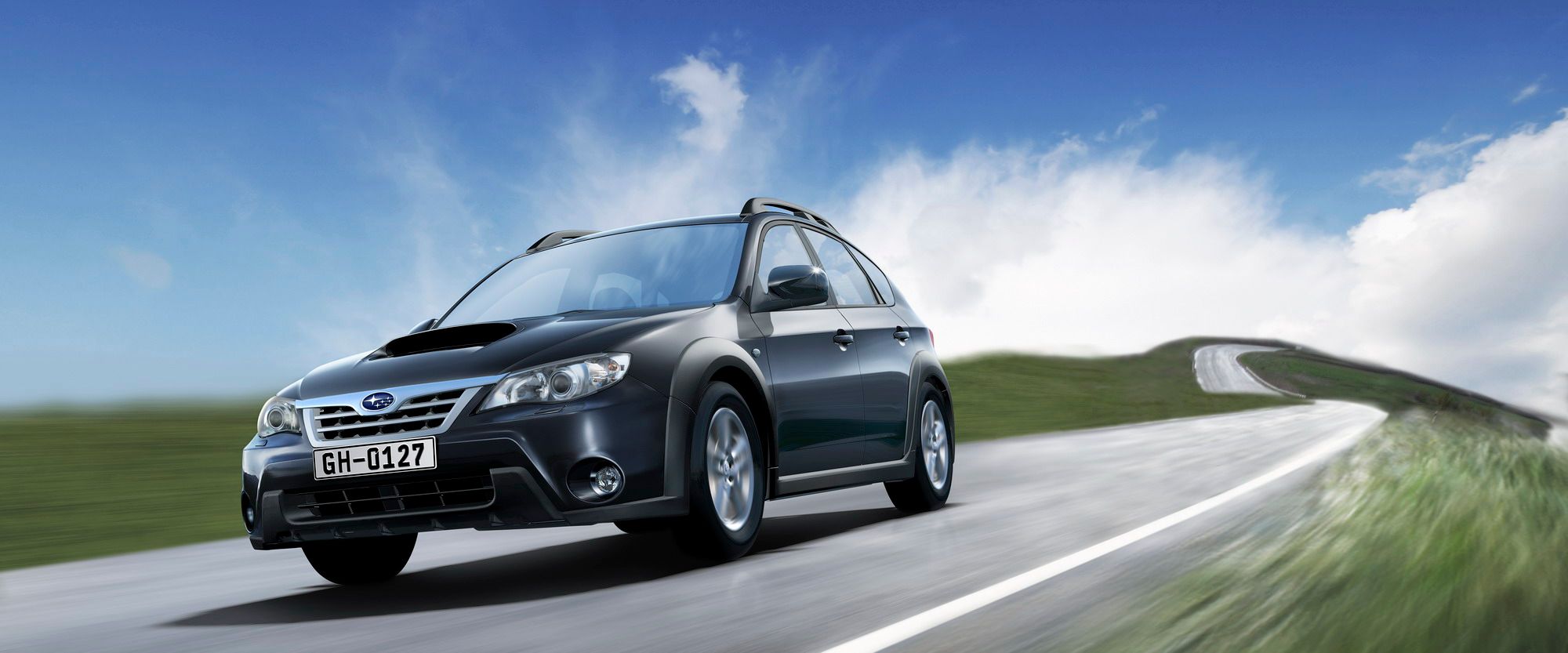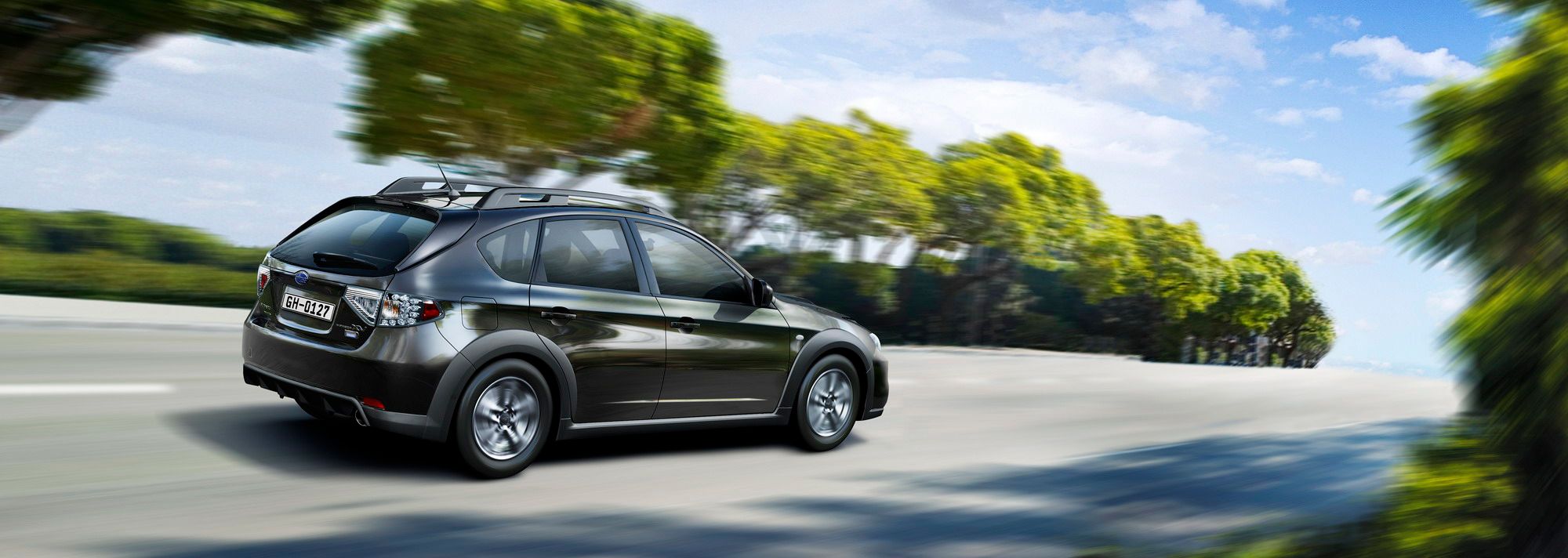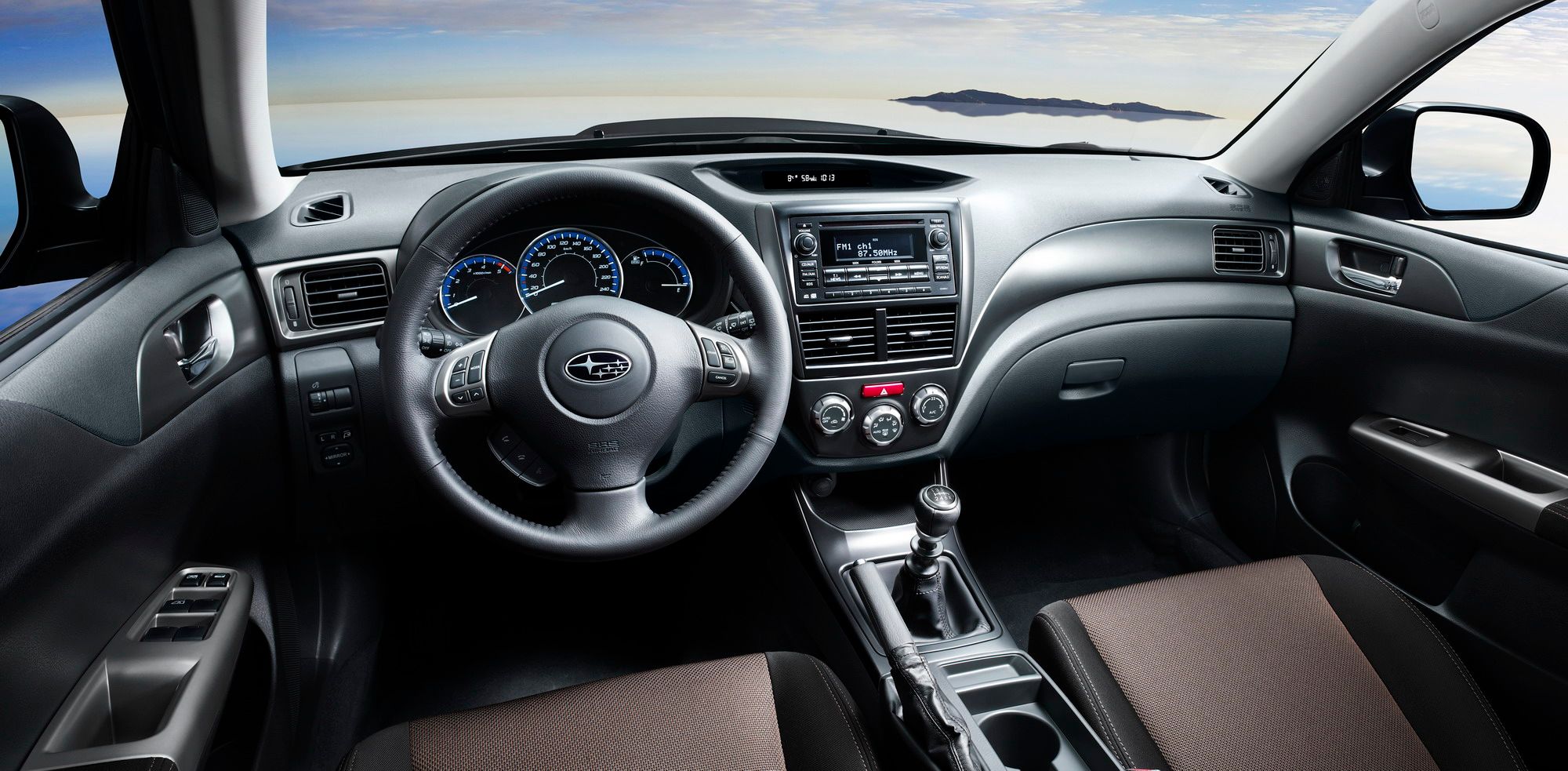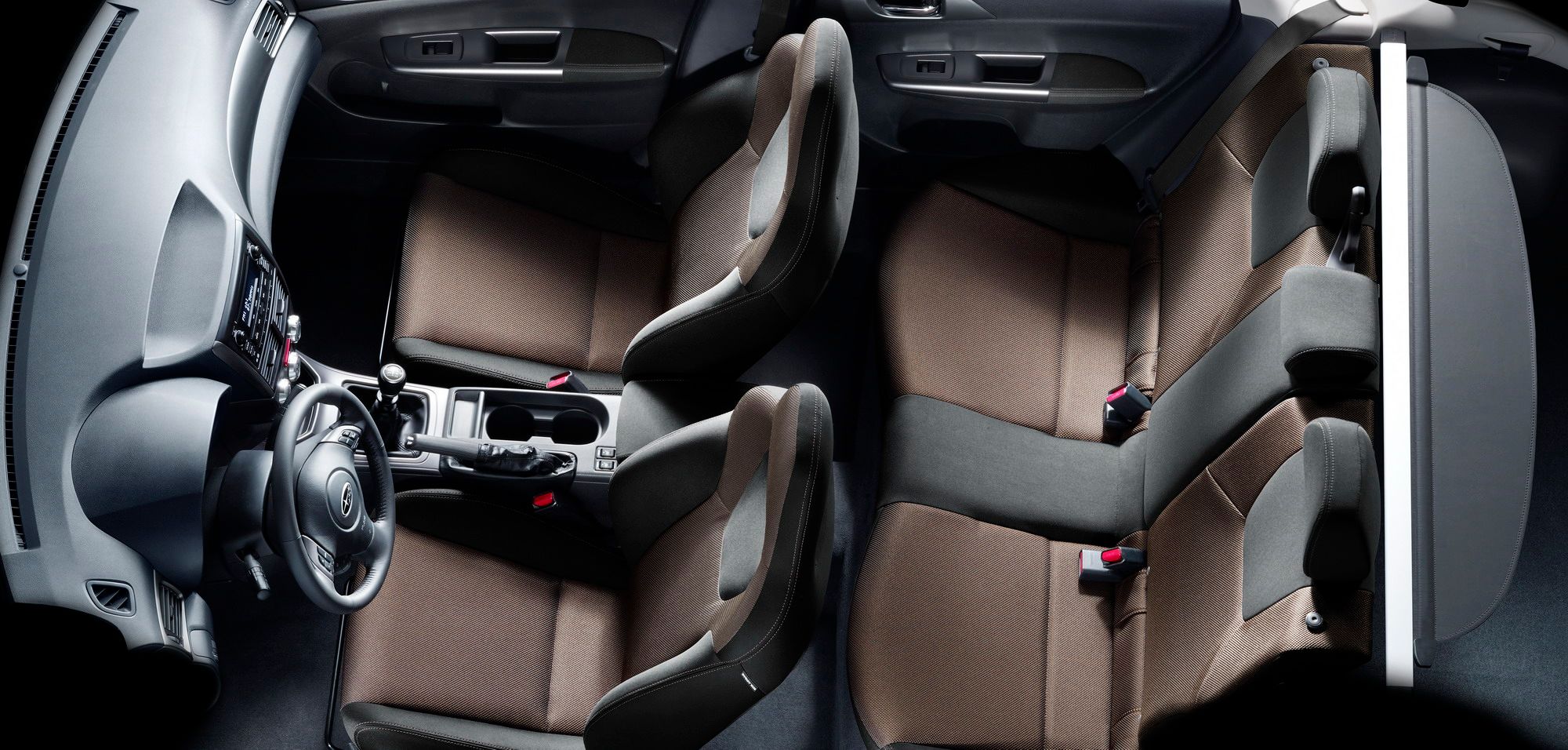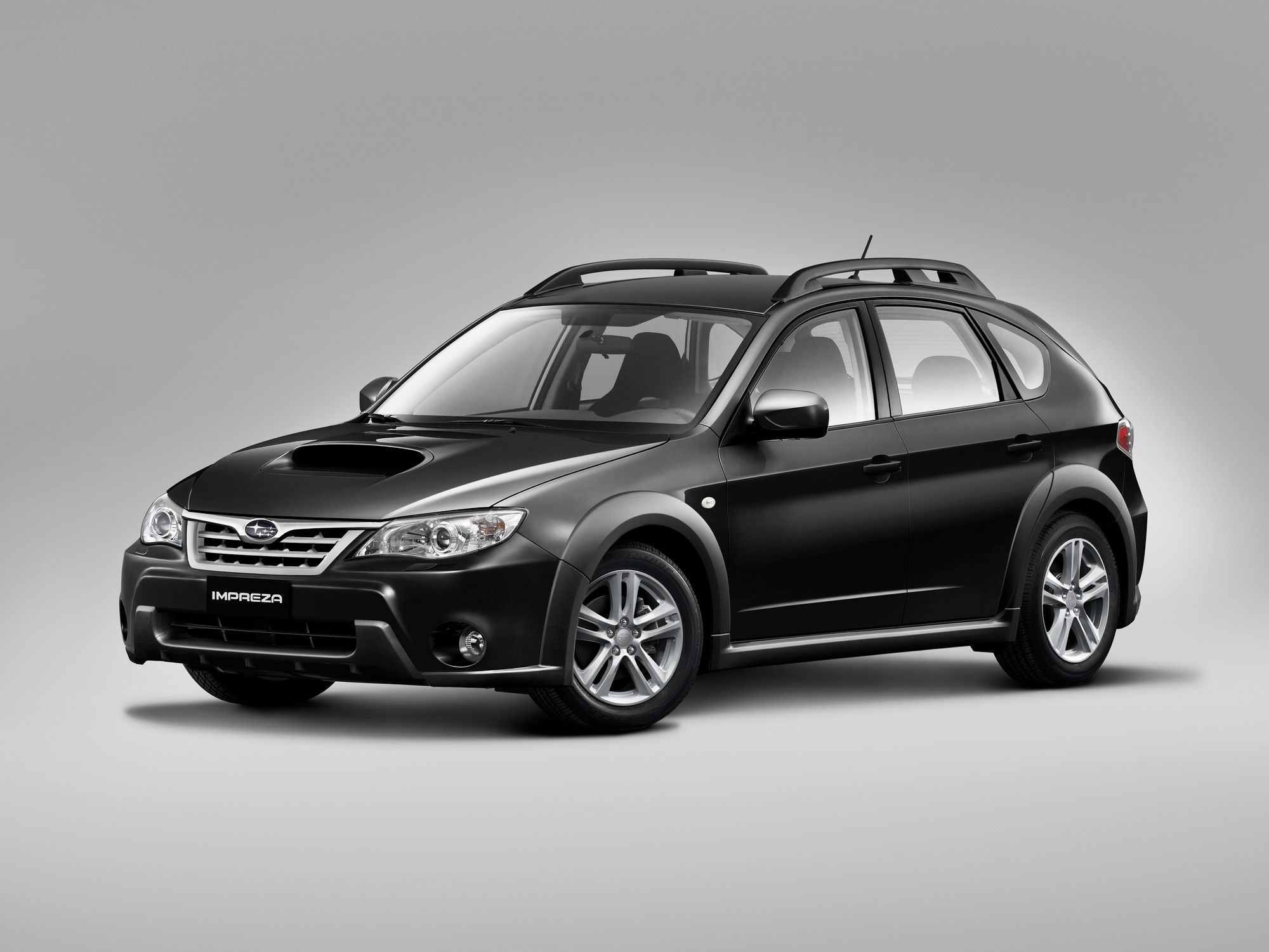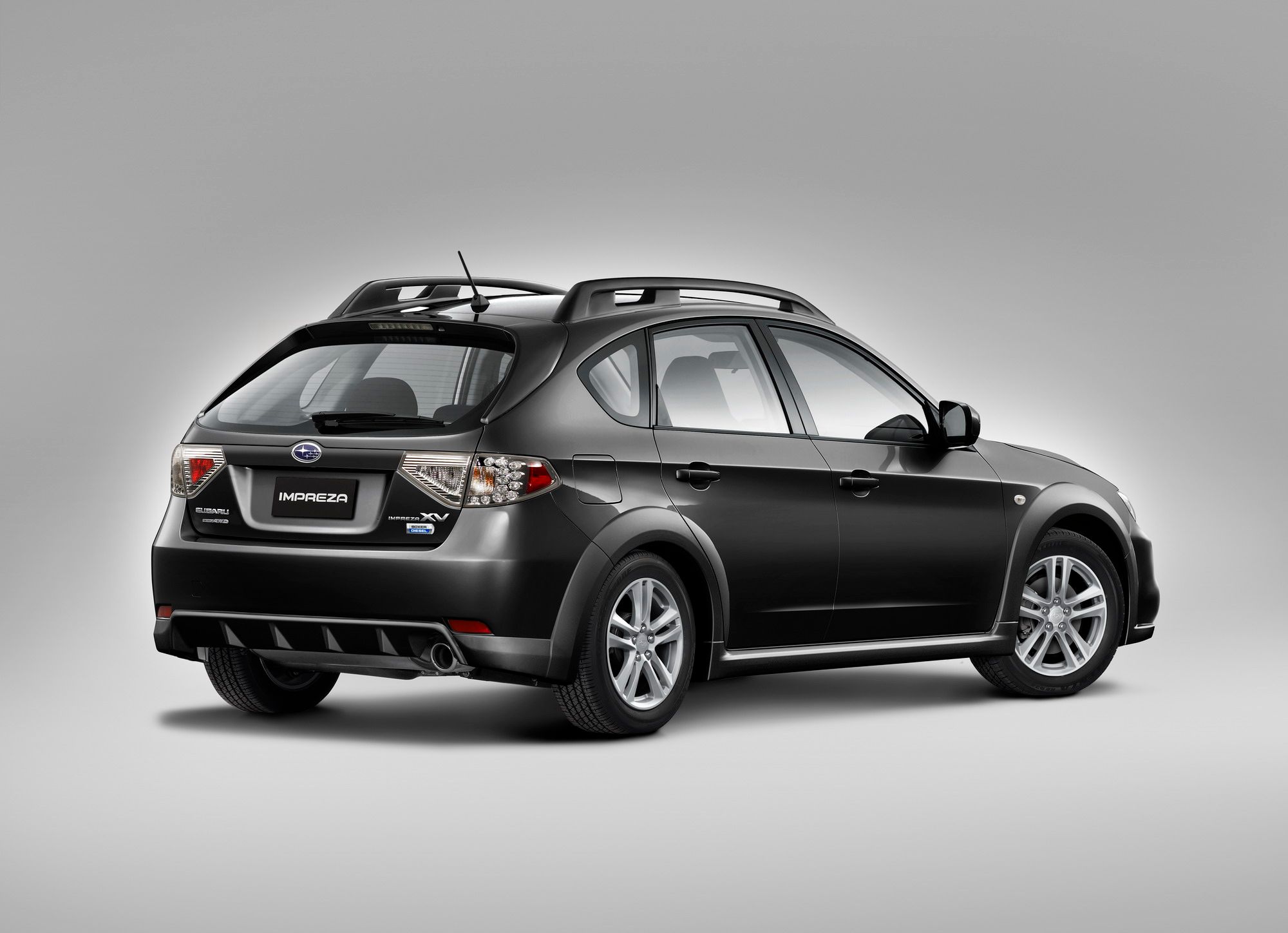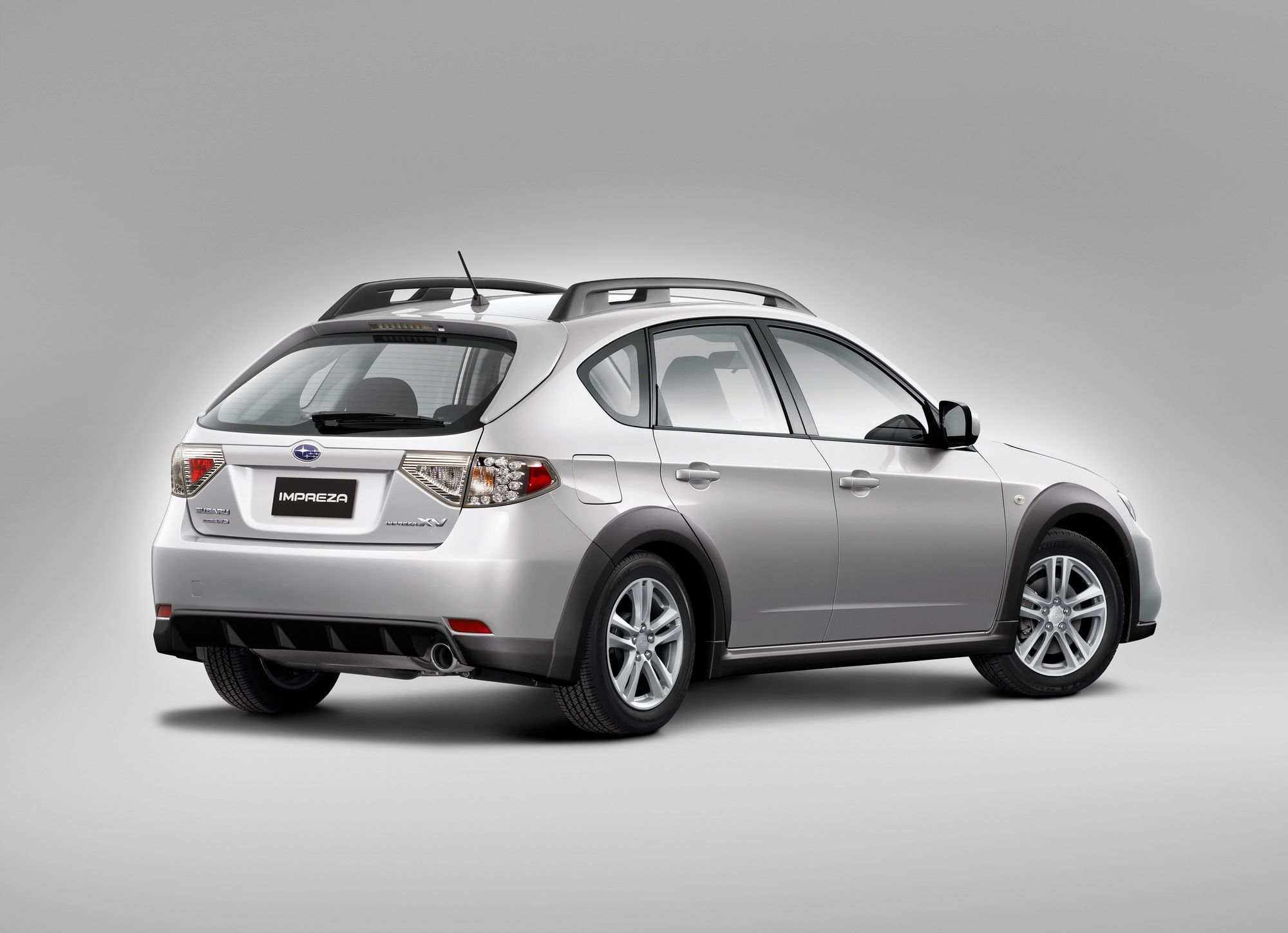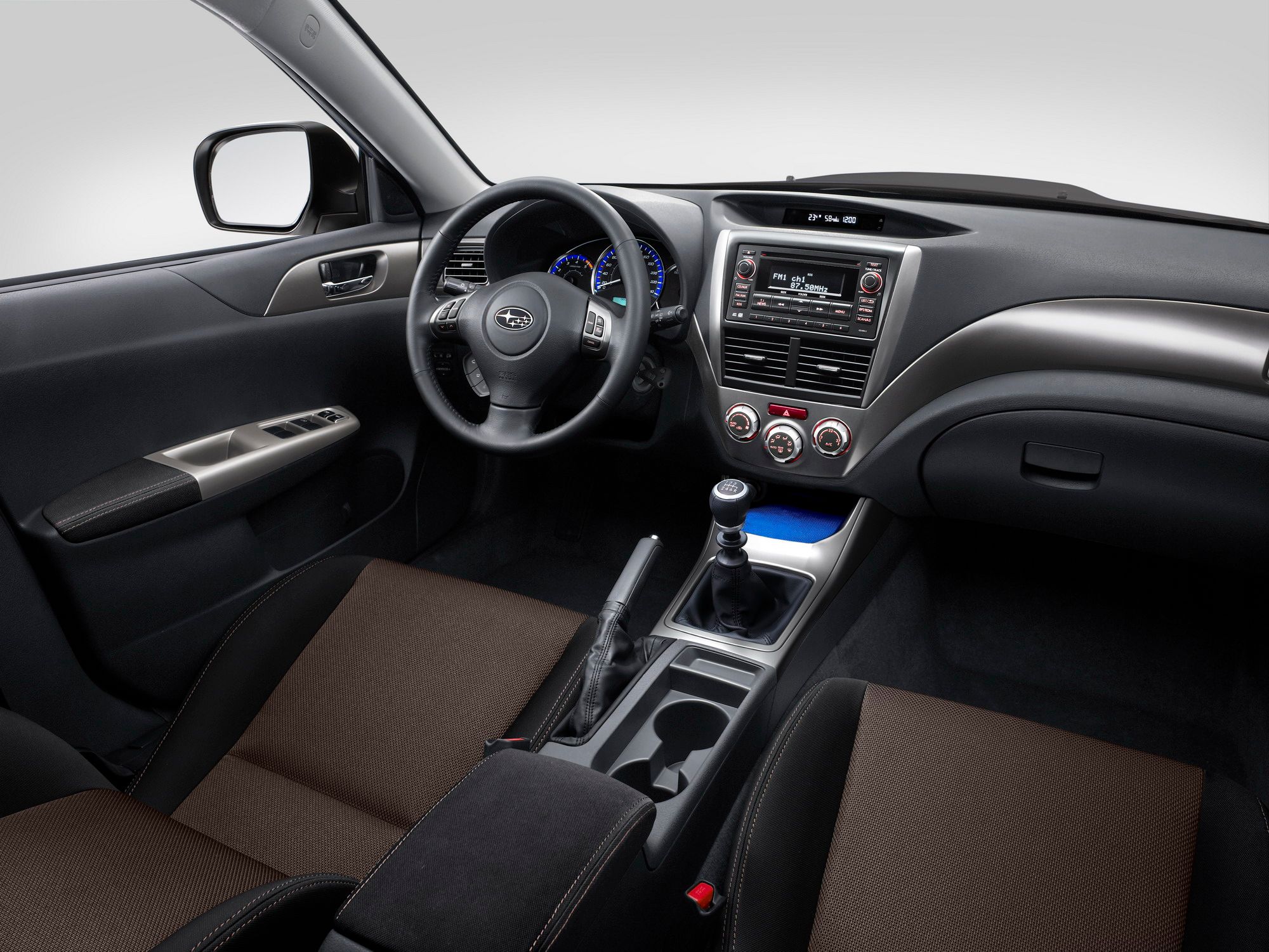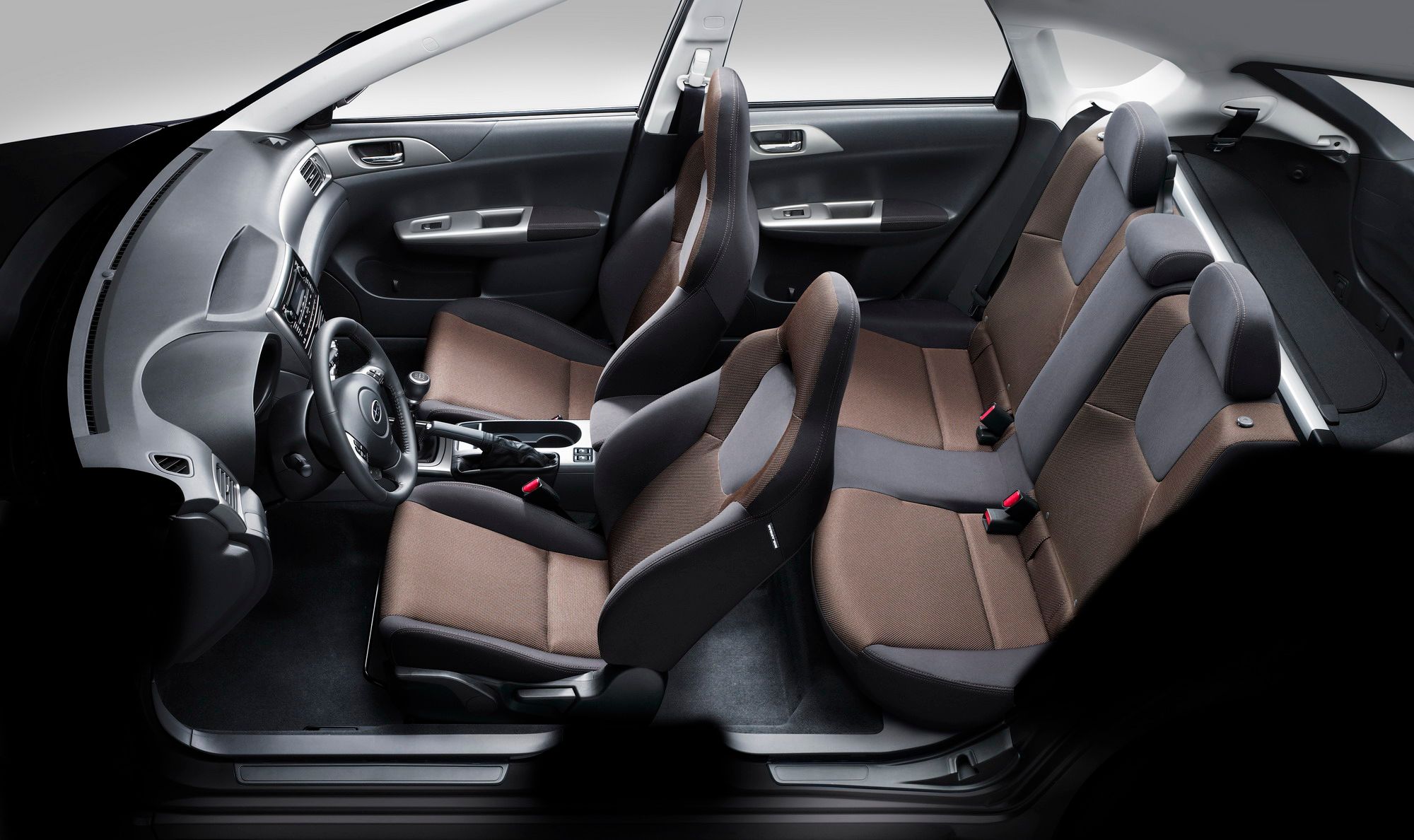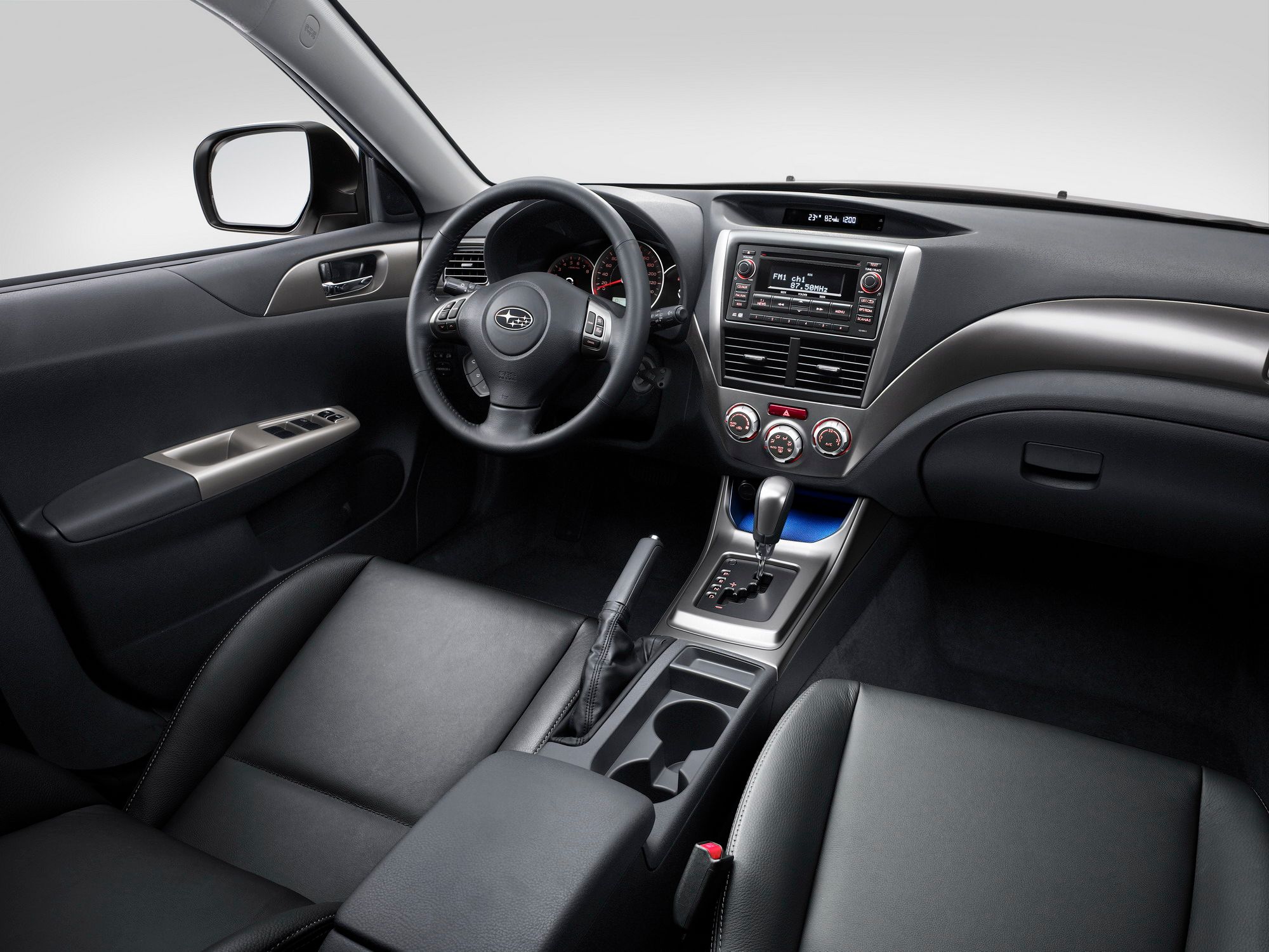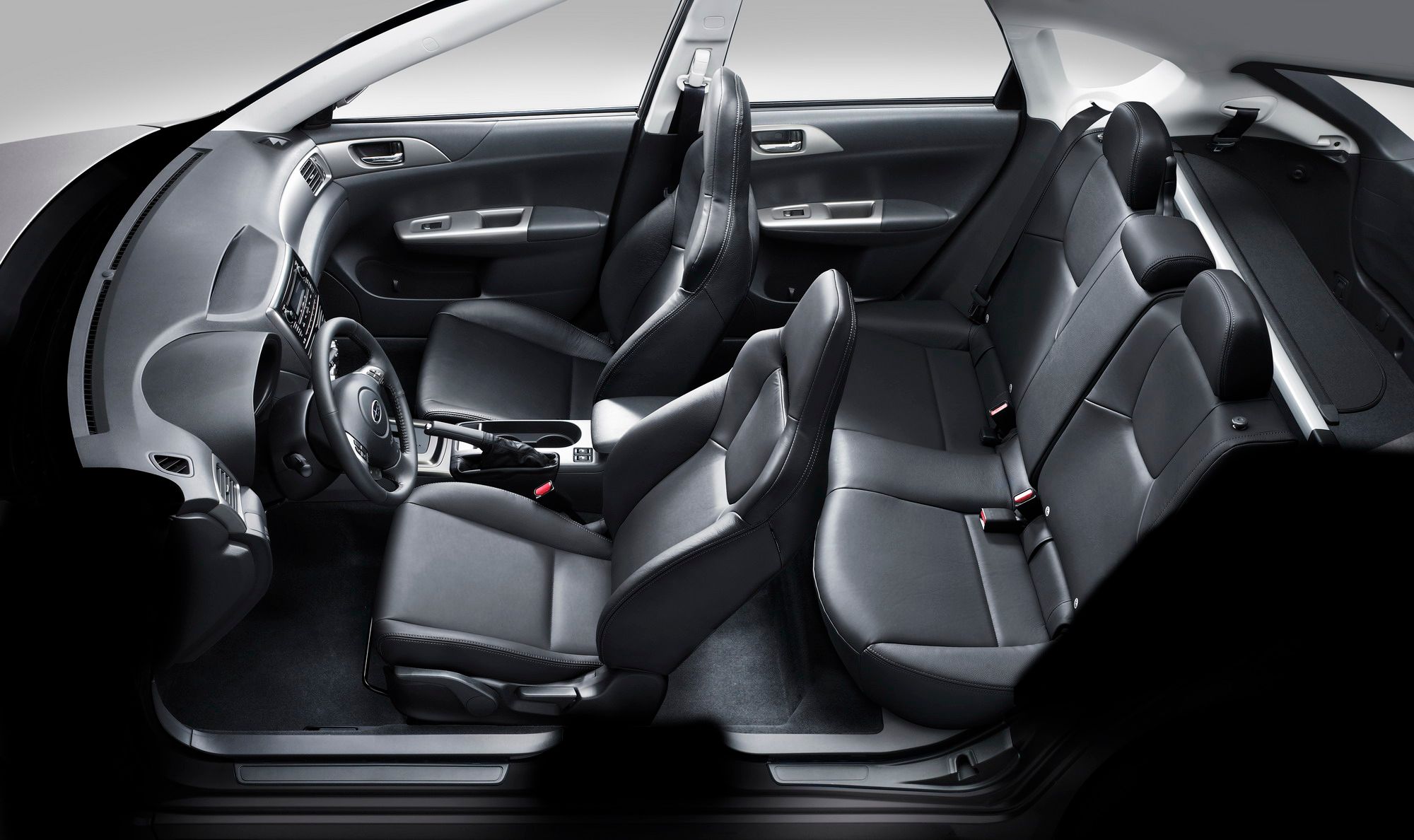Subaru unveiled at the Geneva Motor Show the Impreza XV crossover. Based on the Impreza 5-door model, the new Impreza XV features a totally redesigned chassis offering a class-exceeding ride performance. The crossover will be offered in two versions: 2.0R and 2.0D.
The car's exterior is defined by an exclusively designed grill and bumper, a specially designed thicker rear spoiler and roof rails. The interior is also changed compared to a standard Impreza: the information gauge, audio, and navigation system are laid out along the top of the centre panel, there are bucket seats in two-tone color, audio control satellite switches and Bluetooth hands-free switches on the steering wheel.
The 2,0 liter gasoline engine will deliver a total of 150 hp and 196 NM of torque, while the diesel one delivers 150 HP and an impressive 350 NM. The two engines can be combined to a 6-speed manual, 5-speed manual or 4-speed automatic transmission. All version will be available with S-AWD (Symmetrical All Wheel Drive System) system.
Press release after the jump.
2011 Subaru Impreza XV
- Make: Array
- Model: 2011 Subaru Impreza XV
- [do not use] Vehicle Model: Array
Press release
Developed on the basis of the Impreza 5-door model, the product concept of the Impreza XV is “Active Sports Gear”. It offers a new crossover of “Sport Utility” and “Quality Ride by the Impreza”. The current Impreza model, launched in 2007, was developed around three main key areas: Styling, Functionality and Quality ride. The totally redesigned chassis offered a class-exceeding ride performance. The Impreza XV employs a stiffer suspension while retaining such quality ride. As a result, it delivers the sporty drive character customers would expect find in a passenger car. The XV offers the Impreza’s original and distinctive symmetrical All-Wheel Drive (SAWD) driveability in all-weather road conditions, packaged in a unique exterior.
Exterior
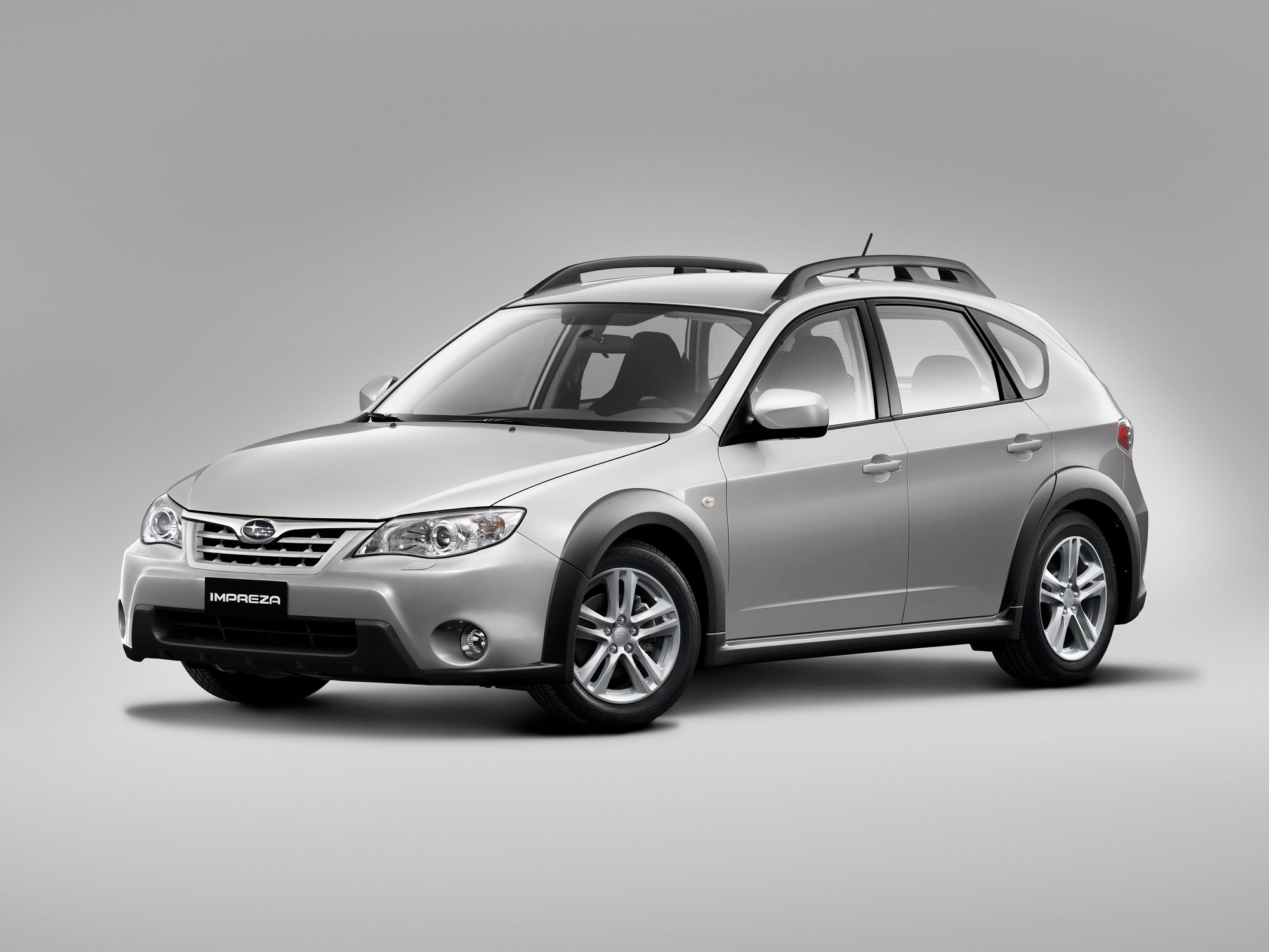 “Casual crossover with active feeling”
“Casual crossover with active feeling”
The bolder front face is accentuated by an exclusively designed grill and bumper. Claddings around wheel arches give a feeling of powerfulness. A specially designed thicker rear spoiler and roof rails enhance the sports utility atmosphere. All those elements emphasize a sense of stability by SAWD and project a Subaru’s compact crossover concept.
Front
The new front grill has the same motif as other Subaru crossovers in its design. Neatly integrated with the front bumper, it imparts an impression of powerfulness to the vehicle. The sharply shaped headlamps, designed with a hawk’s eye motif, and the sporty designed bumper with fog lamps positioned at both ends of it, project a sportiness as well as a crossover look offered by Subaru.
Sides
The wheel arches with impressive claddings give confident road presence to the Impreza XV. In the lower part of the body, which seamlessly consists of the lower part of front bumper, side claddings and side sill, matte black finish parts are featured to create a solid impression in its exterior design. Black aluminium roof rails and rear spoiler underscore its versatility and unique silhouette. Aluminium wheels embody sportiness with a bold three-dimensional spoke design.
Rear
A large roof spoiler, which covers around the glass area of the rear gate, integrated with D-pillars, accentuates boldness and sportiness. Black accent of the lower part of rear bumper
also imparts a crossover taste to its rear view styling. LEDs are employed as brake lamps in the rear combination lamp system. The LED provides not only futuristic essence to the rear end design but also improves the recognition by the following vehicles due to its fast illumination response and high degree of brightness. The “XV” badge is exclusively attached on its rear gate. In addition, the “SYMMETRICAL AWD” badge is attached throughout all AWD models. The XV diesel model is also equipped with a specialized diesel-model rear ornament.
Body colour
- Obsidian black pearl
- Satin white pearl
- Spark silver metallic
- Dark gray metallic
- Camellia red pearl
Interior
Interior design Interior design was differentiated from the regular Impreza model to offer a more active feeling. For the standard fabric seat models, brown accent was specially featured in the interior design, resulting in improved quality and enhanced distinctive characteristic of the XV. Brown stitches are also adopted for the door trim, the surface of console box and arm rests for refined interior space.
Instrument panel
The information gauge, audio, and navigation system are laid out along the top of the centre panel in such a way as to limit as much as possible the movement of the driver’s line of sight and thereby create a comfortable driving environment. Additionally, the centre position of the air conditioning vents clearly separates them from the air conditioning controls in the lower part of the panel. This creates not only a visually sleek design but also provides functionality by allowing the driver to make the necessary adjustments by only having to reach out to the corresponding zone.
Combination gauge
The three gauges are laid out nicely with silver rings. The gauges also have a sweep function in which the indicators move to the maximum position when the ignition key is turned to ON and then quickly return in order to heighten the excitement of driving. The tone of gray printing is specially featured in the design of the lettering plate used in meters.
Information gauge
The information gauge is positioned in the upper part of the centre panel to make it easy to read while driving. The gauge normally displays ambient temperature, average fuel consumption, instantaneous fuel consumption, and the time in digital form.
Seats
The bucket seats provide good back support to both driver and passengers and suggest an active image. Two-toned brown/black fabric seats are standard. Brown stitches also create a
feeling of refined quality interior. The low-rebounding urethane material adopted for the cushions of the front seats improves absorption of vibrations when driving and provide a comfortable drive. The flat-type spring adopted for the back seat provides firm support for the hips and back and ensuring an ideal seating posture. Leather seats are available as an option. (Black tone is only available)
Other standard features
- Leather-wrapped steering wheel
- Audio control satellite switches and Bluetooth hands-free switches on the steering wheel
- Leather-wrapped shift knob (MT model) / Leather-wrapped selector lever (ATmodel)
Packaging
Comfortable and ample passenger compartment
The development of the packaging took as a starting point to become a competitive model in the compact car segment by meeting the demands from customers. By expanding the wheelbase and widening the body, while also reducing the rear overhang, an ample and comfortable passenger compartment was achieved without having to increase the body size any more than necessary. Additionally, spacious headroom is ensured due to optimization of the slant of the side window to create a comfortable interior space in which occupants do not feel cramped.
Enhanced visibilities
In order to reduce stress while driving and improve proactive safety related to sensing and avoiding dangerous driving situations before they occur, the driver’s visibility was enhanced by the reduction of dead angles and a body shape that provides good peripheral vision. The visibility through the rear window was also improved by ensuring that a 1-meter high pole (the average height of a five-year old child) can be easily seen in order to prevent accidents caused when backing up the car.
Luggage space
The compact double-wishbone suspension can reduce the volume of the suspension housing securing wider and flat spaces in the cargo area. The wide spaces at the rear end of the luggage space makes it unnecessary to lean too much into the compartment in order to shove luggage and other items and it will prevent customers from getting dirt or wet by touching the rear bumper. The space is large enough so that two 9-inch golf bags can be laid sideways or five pieces of 22-inch hand luggage can be stored with five persons sitting in the car.
Improved accessibility
Accessibility is improved due to an increased door opening. This was realized thanks to the framed doors with sashes and an optimized shape for the side of the seat cushion. Accessibility for the rear seat was especially improved due to the doors opening at nearly a right angle and vertically angled c-pillars to create a door opening space that provides ample headroom for smooth ingress and egress.
Impreza XV: Comfort
Heater and air conditioning
Due to the adoption of a condenser with a compressor and other components that effectively utilize coolant, air conditioning performance was improved. Additionally, the air resistance within the air conditioning unit was reduced resulting in a 10% increase in the maximum air-flow volume, and system noise suppression was also greatly improved. Operability was improved with the three-dial controller and the illumination of the slotted ring behind the dials with illumination adds a touch of luxury.
Audio
<CD player and AM/FM tuner with Bluetooth hands-free system (Standard)>
This 10-speaker system combines a1-CD player and AM/FM tuner. In addition, Bluetooth* compatible hands-free system is equipped as standard. Satellite switches for audio control and Bluetooth hands-free system on the steering wheel are added to improve ease of operation while driving. USB jack is available for iPod*. Music is controllable though the audio system.
Reduced interior VOCs
Materials and adhesives used in the vehicle interior are carefully selected in order to reduce the use of volatile organic compounds such as formaldehyde and toluene.
Utility
Roof rails
Black aluminium roof rails were exclusively designed. They accentuate versatility and unique crossover look.
Power sliding, tilt-adjustable glass sunroof (Optional)
A sunroof with dark tinted glass is available. The auto-slide function features a reverse slide mechanism. It provides ample headroom without the cramped feeling found in some vehicles fitted with a sunroof.
Wiper de-icer control
The wiper de-icer does not operate in range where the wiper de-icer function is not required (outside temperature of 5 degrees or higher). This avoids unnecessary power usage and contributes to better fuel efficiency.
Security
The security system uses an immobilizer vehicle control unit (standard on all models) that verifies the ID code of the electronic chip contained in the key, and only allows the engine to be started if the proper key is correctly identified. In addition to protecting against the engine starting by means of a counterfeit key or similar action, the communication data is changed every time the engine is started in order to prevent vehicle theft by copying of the internal
data.
Main interior storage space
Large door pockets: Large enough to hold a 720 ml drink bottle or thin tissue paper box.
Glove box: Large enough to store 12 CDs, and features a lid damper and LED lighting.
Centre tray: Large enough to store four CDs. LED light is featured in the bottom of the tray.
Cup holders: Cup holders located in the floor console are large enough to hold a coffee mug.
Floor console box: Large enough to hold eight CDs. The console box also includes an auxiliary plug jack, USB/iPod jack and a DC 12V/120W electrical socket.
Other equipment
- Rear gate opener with electromagnetic switch
- Engine bonnet with gas damper
- HID headlamps with Pop-up type headlamp washers (Optional)
- Front seat heater
- Heated door mirrors
- Removable coat hooks with the rear seat hand rails
Engine
This powerful unit provides a high level of balance among output/torque, fuel economy, and environmentally considerate characteristics to offer smooth handling and a carefree driving experience. Exhaust emission control performance is compliant with Euro 5 standards.
SUBARU BOXER 2.0-litre DOHC NA
Optimized intake system
- (1) The intake manifold arranges the air provided to each cylinder to match the firing order, causing the intake air to form a vortex that improves intake efficiency. A resin-type was adopted for weight savings and to meet the power output characteristics.
- (2) The intake ports were designed to intensify tumble gas flow and also improve intake performance. The synergistic effect of these two features results in improved low/intermediate range torque, output at high engine speed, and response in all ranges.
Equal length constant pulsation exhaust system
This exhaust system reduces exhaust interference between cylinders to increase exhaust efficiency and provide superior torque characteristics in all ranges. The rear catalysts is optimally-positioned to improve exhaust gas emissions.
Secondary air system
A secondary air system was adopted to improve exhaust gas emissions when starting the engine. By passing secondary air around the cylinder head when starting the engine with cold temperature, unburned gas is burnt again. This also allows the catalyst to activate faster to reduce hydrocarbon emissions.
Reduced friction
A reduction in friction due to optimization of cooling and oil pump efficiency resulted in improved fuel economy and cleaner exhaust gases.
SUBARU BOXER DIESEL 2.0-litre DOHC turbocharged engine
I. Features & Benefits
Low vibrations and noise
- The movements of the horizontally-opposed pistons work in unison to effectively cancel out the second harmonic vibration (vibration at double the frequency of the engine’s revolution) that causes discomfort in drivers. Thanks to this structural advantage, the SUBARU BOXER DIESEL does not need balancer shafts which are commonly used in conventional in-line and V-type engines. The compactly designed crankshaft sandwiched by the highly rigid cylinder blocks helps minimizing an uncomfortable noise and vibration up to high rpm’s.
Superior engine response and good fuel economy
- No need for balancer shafts leads to low rotational inertia and friction within the engine itself. The result is exceptional accelerator response and good fuel economy.
Contribution to the handling performance
- The bore pitch was shortened and the left and right blocks holding the crankshaft provide a highly rigid design compared to the conventional in-line engines, which has also allowed use of an aluminium alloy cylinder block for weight savings.
- In addition to the low centre of gravity provided by the structure of the Horizontally-Opposed Engine, the placement of the turbocharger unit at the lower part of the engine functions to maintain a low centre of gravity for the diesel engine, which tends to be quite heavy in weight.
- These engine features contribute to excellent handling performance.
II. Mechanism
1. Cylinder block
Cylinder block
An aluminium alloy cylinder block is used to maximise the potential of the highly rigid Horizontally-Opposed Engine layout. To obtain ideal diesel combustion, the stroke was extended by 11 mm and the bore was shortened by 6 mm compared to the SUBARU BOXER four-cylinder 2.0-litre petrol engine (EJ20). The bore pitch was shortened to 98.4 mm, which is similar to that of SUBARU BOXER 6-cylinder petrol engine, while the petrol engine (EJ20) has 113.0 mm. This led to a 61.3 mm reduction in engine block length for even more compact design.
Semi-closed deck: The block design uses the semi-closed deck type that has proven its durability in the turbocharged petrol models. This increases rigidity around the head gasket mating areas.
Metal matrix composite journal: All 5 main bearings (journals) in the cylinder block incorporate metal matrix composite journals (which are inserted during the casting process), resulting in superior levels of quietness due to high rigidity and similarity in thermal expansion ratio to that of crankshaft.
Extra cooling channels: Cooling slits were given between the cylinder bores to operate as water cooling channels, thus improving cooling performance.
Pistons
High strength materials were used to withstand the high combustion pressures of the diesel engine. Cooling channels within the pistons are incorporated, with engine oil squirted via oil jets, which enhances piston cooling. The optimal shape of piston crowns and improvements made to gas flow within the combustion chamber improve combustion efficiency, reduced NOx and PM (particulate matter). As a result, they improved exhaust gas emissions.
Connecting rods
The large ends of the connecting rods feature an asymmetrical profile, which increases precision during assembly and in roundness of the surface connecting the crankpin for reduced friction. It also contributed to minimize the rotational path thus enabled to employ extended piston stroke inside the compact cylinder block.
Crankshaft
The crankshaft in the BOXER DIESEL is shorter and lighter compared to conventional in-line engines due to its overwrapping bore arrangement between both banks. This minimizes the bending moment caused by the combustion pressure and contributes to lower noise level in higher rpm’s. The high strength crankshafts underwent surface treatment to withstand the high combustion pressures of a diesel engine.
Glow plugs
Ceramic type glow plugs were adopted. This raised the maximum temperature, providing better start-up at cold temperatures and stability.
2. Valve system / intake and exhaust system
Cylinder head
High strength cylinder heads were used to withstand the high combustion pressures.
Roller rocker arms: Compact and low friction end pivot type roller rocker arms were used in combination with the double overhead cam (DOHC) system.
Valve System: The diameter of the intake valves was optimized for enhanced breathing performance and swirl ratios, resulting in improved combustion efficiency.
Intake ports
The combination of an intake swirl pot system and optimized intake valve diameter results in ample swirl performance.
Intake manifolds
A resin-type intake manifold was adopted. Compared to the former aluminium type, the weight was reduced by around 1,600g. This improved torque characteristics and fuel efficiency.
Cam drive system
A highly durable chain system was used to drive the camshaft to handle the variations in torque produced by the diesel engine.
3. Common rail system
A common rail system is used for fuel delivery for better performance. The fuel is pressurized to 180 MPa before being fed into the common rail. In the Impreza XV BOXER DIESEL models, a latest system was adopted, thus exhaust gas emissions were improved by optimising control of injection.
Solenoid injectors: Specially designed injectors are used. A shorter overall length of the injector contributed to maintain overall engine width as that of the regular petrol engine despite the longer piston stroke.
4. Turbocharger
A variable nozzle type turbocharger was specially designed to deliver ample turbocharged
performance across the entire engine range. The turbocharger itself is positioned under the engine and mounted directly to the catalytic converters for increased environmental friendliness. Response is improved while also helping to lower the centre of gravity. A lift sensor was added to the turbocharger. Exhaust gas emissions were enhanced by improving control of variable vanes.
5. Exhaust
The exhaust system was fine tuned for use with the diesel engine.
6. Exhaust emission control system
A closed-type of diesel particulate filter (DPF) was adopted for the exhaust emission control system. This system also complies with European EURO 5 exhaust gas regulations for better environmental friendliness.
The DPF is positioned together with the turbo charger at the lower part of the engine. This not only improves exhaust gas purification performance, but also helps keeping the centre of gravity low, thus contributing further enhance the superb handling performance originated by the symmetrical AWD.
Oxidation catalytic converter
The catalytic converter separates un-burnt fuel into water and carbon dioxide. The unit is made compact enough to be activated soon after the engine was started. If the temperature rises to 300°C under certain driving conditions, the oxidation catalytic converter generates NO2, which oxidises collected diesel particulates inside the DPF.
Closed Diesel Particulate Filter (DPF)
The adoption of a closed DPF functions to improve engine combustion efficiency and reduce particulate matter (PM) in the exhaust in order to further enhance environmental friendliness.
The closed DPF features a honeycomb shaped filter made of silicon carbide. The filter channels are blocked on alternating ends of each side and there are also microscopic pores on the inner filter wall, thereby functioning to effectively collect the PM as the exhaust gas passes through these microscopic pores.
The collected PM is combusted inside of the filter, which reaches 600°C and higher depending on operating conditions, and repeatedly regenerated to be emitted as carbon dioxide. Conversely, if the internal filter temperature is low with a continuous load operation, the temperature within the layers is controlled to cause combustion of the PM, which is then repeatedly generated, processed, and emitted as carbon dioxide.
EGR (Exhaust Gas Recirculation) system
An EGR system is used to comply with European EURO 5 exhaust gas regulations. The cooled exhaust gas is fed back into the combustion chamber to lower the combustion temperature and reduce NOx emissions. An enlarged EGR cooler was adopted for better exhaust gas emissions.
7. Engine mounting system
A liquid-filled engine mounting system is employed for even less vibration and better handling performance.
Impreza XV: Drivetrain
Symmetrical layout
The fundamental support of the Impreza XV driving experience is Subaru’s unique left-right symmetrical powertrain; all aspects of which were carefully fine-tuned to provide substantial driving excitement together with optimal fuel economy. This innate handling agility was even enhanced in Impreza XV by lowering the engine mounting position. A powertrain with a low centre of gravity further accentuates the Impreza XV’s excellent driving characteristics and feeling.
Symmetrical AWD (All-Wheel-Drive) system
The AWD is carefully designed to fit all elements of the Impreza XV, such as ensuring optimal combination with the engine and transmission, in order to further develop the advantages of Subaru’s unique Symmetrical AWD that we have developed for many years behind our horizontally opposed engine as its core technology.
Active torque split AWD (E-4AT)
This electronically controlled AWD provides excellent driving stability and high traction due to its ability to react quickly to sudden changes in road surface attained by constant monitoring of the driving conditions of all four wheels and engine torque, and by instantaneous control of front/rear wheel torque distribution. Distribution of drive force is distributed to maintain torque loss at a minimum and thereby contribute to fuel-efficient driving.
Centre differential AWD with viscous LSD (5MT with dual range, 6MT)
This manual transmission AWD utilizes a bevel gear centre differential. Together with the 50:50 basic torque distribution to the front and rear wheels, the LSD with viscous coupling limits torque differential to maintain excellent vehicle stability when cornering.
Electronic control 4-speed automatic transmission with SPORTSHIFT* (SS E-4AT*) (2.0R AT model)
The adoption of a direct control transmission capable of minute speed control provides a gearshift feeling with excellent response and minimum shift shock, as well as improving fuel economy. The selector lever features four positions: P-R-N-D. The sport shift feature is adopted for all AT models to allow drivers to enjoy the feeling of manual shifting.
Neutral control
When the brake pedal is pressed and held down for a certain amount of time while waiting at a stop light or similar circumstances, the transmission is shifted into neutral internally in order to improve fuel economy. The transmission is automatically resumed to the D-range when the brake pedal is released.
Dual-range 5-speed manual transmission (2.0R MT model)
This transmission further improves the moderate yet brisk and solid shift feeling normally associated with a longitudinal layout while providing improved noise reduction and drive feeling. An auxiliary reduction gear with hi-low selection is a traditional feature of Subaru that preserves driving performance in steep up hills, towing and similar conditions.
6-speed manual transmission for SUBARU BOXER DIESEL (2.0D model)
6-speed manual transmission was specially developed for the diesel model. The gear ratios
are fine tuned to match the output characteristics of SUBARU BOXER DIESEL with Impreza XV. This transmission has the same length as a 5-speed manual transmission due to efficiently engineered gear layout and shift-link configuration, resulting in a compact and lightweight 6-speed transmission. Optimization of the gear ratios, strong torque characteristic of a diesel engine, and the effects from creating a wide ratio results in a transmission that can cover all types of driving, from the city to the expressway.
Chassis
Subaru Dynamic Chassis Control Concept (Subaru DC3)
- (1) The combination of superb steering response, flexible chassis and greatly improved road holding performance in the rear suspension provides drivers with a wholly pleasurable driving experience.
- (2) Improved road holding of the tyres and supple absorption of road bumps provide superior ride and comfort.
- (3) The whole chassis package provides a comfortable passenger compartment for the driver and all passengers, and an easy to access luggage space as well.
The Subaru DC3 is generated based on an approach that brings a high level of balance among the three elements listed above. Significant progress is achieved in the comfort, security, and drivability provided for everyday use of the car.
Suspension
A strut-type suspension system, developed and perfected over many years at Subaru, was adopted for the front suspension. In addition to improvements in linear controllability and stability together with improved ride and comfort, overall weight is reduced due to the integration of component parts. A double wishbone suspension system was adopted for the rear suspension. In addition to providing excellent stability and reduced component size, a substantially large and easy to access luggage space was achieved by lowering the suspension further below the floor. Additionally, attaching the suspension to the body via a sub-frame suppresses shocks from the road surface and similar factors to provide excellent riding comfort and improved noise reduction. Suspensions of the Impreza XV were finely tuned. The model delivers agile handling and sporty driving by enhancing roll rigidity and improving marginal g-force.
Brakes
A highly reliable brake system that furnishes a feeling of complete safety when used on all types of road surfaces, and in all driving and weather conditions is adopted in order to provide all drivers no matter their driving skills with a pleasant and satisfactory driving experience.
- Tie-rod type tandem brake booster
- A tie-rod type system booster that minimizes the expansion of booster shell while generating brake pressure, is adopted. This brake booster improves not only the absolute brake performance but also the secured brake feeling.
- ABS with Electronic Brake-force Distribution (EBD)
- The standard ABS provides both braking performance that prevents early wheel lock-up and steerability. EBD is also included in order to provide optimal braking force to each wheel according to passenger and cargo weight.
Tyres and wheels
- 205/55R16+6.5J Aluminium wheels are equipped as standard.
- A flat tyre repair kit is optional for 2.0D model for weight reduction.
Electric power steering system (2.0D model only)
A pinion electronic power steering system was adopted. Assist characteristics are optimized in consideration of the use of a diesel engine, resulting in a simple and direct steering feeling.
Body and Safety
Ring-Shaped Reinforcement Frame
The unique Subaru body structure features not only the ring-shaped frame forms around each pillar, but also the complete openings of both rear and front doors are reinforced with a similar additional ring-shaped formation. This structure is used as a base for the Impreza models to which we optimized body construction by adding the most advanced impact absorption technology as well as applying various types of high-strength steel plates where they will be most effective in order to provide a safe, secure, and comfortable driving experience. This also results in a reduction of overall vehicle weight.
Body structure improvements
The side body structure was completely redesigned by applying the basic philosophy underlying Subaru’s world-renowned ring-shaped reinforcement frame. By adopting a door with a sash, a high degree of balance was achieved between rigidity, strength, and lightweight together with an enlarged door opening. The body structure offers both a high level of rigidity, which is directly related to improved driving performance and comfort, and also superior collision safety to protect occupants in case of an accident.
Collision safety for all directions
Using the ring-shaped reinforcement frame, with its reputation for safety, as a base, Subaru further increased collision safety performance for the front, rear, and both sides. This is especially important for the rear where sufficient collision absorption capability had to be ensured even as the size of the overhang was reduced. In order to achieve this, a rational structure was adopted to absorb and disperse impact energy efficiently throughout the body.
Improved safety features around the doors
The structure was adopted to ensure a high degree of protection through impact absorption features for side collisions and also to permit easy escape for occupants.
Structure to prevent being trapped
A structure is adopted to prevent occupants from being trapped by ensuring that both front and rear doors can still be opened after a collision.
Remote cable connection
The doorknob and latch are connected with a cable to ensure that doors can be opened when occupants are escaping the car.
Rear door catcher mechanism
A catcher is added to the door lock striker near the side sill that prevents excessive door deformation and suppresses incursion of the doors during side collisions. This feature improves collision safety and reduces the overall vehicle weight.
Improved rear end safety features
A structure was adopted in which the rear frame height is the same as that of the normal height of the front bumper of passenger vehicles. This layout functions to absorb and disperse weight during a collision and also to allow the frame to gradually absorb crushing impacts from the rear end of the car.
Pedestrian protection
The hood frame structure and material, wiper structure and other components are optimized to provide efficient energy absorption during collisions. These features lessen the impact to pedestrians in during collisions.
Powertrain structure that improves impact absorption
The horizontally opposed engine and vertical transmission effectively reduce injuries to occupants during a front-end collision. The engine and transmission are designed to drop down along the body floor surface in order to prevent incursion into the interior of the vehicle and decrease the possibility of secondary injuries to the occupants.
SRS side airbags and SRS curtain airbags
Standard-equipped SRS side and curtain airbags greatly contribute to reducing injuries to occupants during side collisions by greatly increasing the protected area resulting in a significant improvement to collision safety features.
Whiplash reducing front seat
Headrest
The headrest functions to prevent excessive turning at the neck by quickly restraining the head in order to reduce the possibility of whiplash and similar injuries, while also softening impacts to the head.
Seatback
Entire seatbacks absorb the force when passengers are pushed backward.
Others
Safety pedal
A safety structure is adopted for the brake and clutch (MT models only) pedals, and the footrest (AT models only) in order to reduce injuries to the lower body of the driver.
Impact reducing interior
An impact absorbing structure is adopted for all pillars and the interior of side rail trims in order to prevent secondary impacts between occupants and interior equipment during collisions in cars not equipped with curtain air bags.
Vehicle Dynamics Control (VDC) System
The Vehicle Dynamics Control (VDC) system that provides the anti-skid function and realizes high driving and safety performance is equipped as a standard feature. Making use of the excellent drivability provided by the Symmetrical AWD, this unit only operates when truly dangerous driving conditions are experienced: the system ensures vehicle stability when needed. This provides driving excitement without compromising Subaru’s renowned driving safety. Superior driving stability is realized by closely monitoring vehicle behaviour and flexibly controlling ABS (anti-lock brake system), TCS (engine control and brake LSD control for traction control), and VDC (engine control and brake control for anti-skid) based on the
information fed from the sensors.

